oop实验一
实验任务一
源代码

void test1(); void test2(); void test3(); int main() { std::cout << "测试1: \n"; test1(); std::cout << "\n测试2: \n"; test2(); std::cout << "\n测试3: \n"; test3(); } template <typename T> void output(const T &c) { for(auto &i : c) std::cout << i << ' '; std::cout << '\n'; } void test1() { using namespace std; string s0{"0123456789"}; cout << "s0 = " << s0 << endl; string s1(s0); reverse(s1.begin(), s1.end()); cout << "s1 = " << s1 << endl; string s2(s0.size(), ' '); reverse_copy(s0.begin(), s0.end(), s2.begin()); cout << "s2 = " << s2 << endl; } void test2() { using namespace std; vector<int> v0{2, 0, 4, 9}; cout << "v0: "; output(v0); vector<int> v1{v0}; reverse(v1.begin(), v1.end()); cout << "v1: "; output(v1); vector<int> v2{v0}; reverse_copy(v0.begin(), v0.end(), v2.begin()); cout << "v2: "; output(v2); } void test3() { using namespace std; vector<int> v0{0, 1, 2, 3, 4, 5, 6, 7, 8, 9}; cout << "v0: "; output(v0); vector<int> v1{v0}; rotate(v1.begin(), v1.begin()+1, v1.end()); cout << "v1: "; output(v1); vector<int> v2{v0}; rotate(v2.begin(), v2.begin()+2, v2.end()); cout << "v2: "; output(v2); vector<int> v3{v0}; rotate(v3.begin(), v3.end()-1, v3.end()); cout << "v3: "; output(v3); vector<int> v4{v0}; rotate(v4.begin(), v4.end()-2, v4.end()); cout << "v4: "; output(v4); }
运行结果
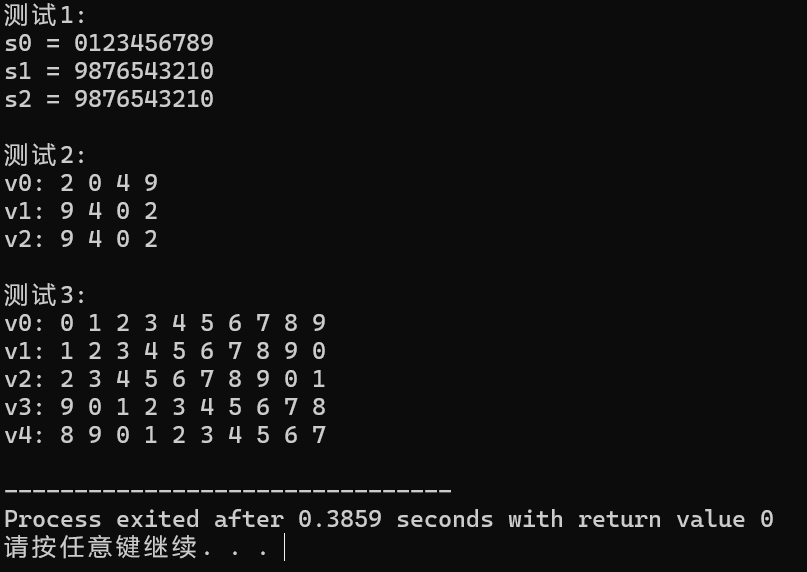
问题1:reverse是直接修改原数组,即使用后原来的顺序没有了。而reverse——copy是将反转后的新结果存储到新的地方,而原顺序不变还存在。
问题2:rotate通过把开头的元素移到元素末尾部分来改变元素顺序的。第一个参数指需要移动的开头元素的位置,第二个参数指需要移动的末尾元素位置,第三个参数指要改变顺序的整个元素中末尾元素的位置。
实验任务二
源代码

#include <iostream> #include <vector> #include <algorithm> #include <numeric> #include <iomanip> #include <cstdlib> #include <ctime> template<typename T> void output(const T &c); int generate_random_number(); void test1(); void test2(); int main() { std::srand(std::time(0)); std::cout << "测试1: \n"; test1(); std::cout << "\n测试2: \n"; test2(); } template <typename T> void output(const T &c) { for(auto &i: c) std::cout << i << ' '; std::cout << '\n'; } int generate_random_number() { return std::rand() % 101; } void test1() { using namespace std; vector<int> v0(10); generate(v0.begin(), v0.end(), generate_random_number); cout << "v0: "; output(v0); vector<int> v1{v0}; sort(v1.begin(), v1.end()); cout << "v1: "; output(v1); vector<int> v2{v0}; sort(v2.begin()+1, v2.end()-1); cout << "v2: "; output(v2); } void test2() { using namespace std; vector<int> v0(10); generate(v0.begin(), v0.end(), generate_random_number); cout << "v0: "; output(v0); auto min_iter = min_element(v0.begin(), v0.end()); auto max_iter = max_element(v0.begin(), v0.end()); cout << "最小值: " << *min_iter << endl; cout << "最大值: " << *max_iter << endl; auto ans = minmax_element(v0.begin(), v0.end()); cout << "最小值: " << *(ans.first) << endl; cout << "最大值: " << *(ans.second) << endl; double avg1 = accumulate(v0.begin(), v0.end(), 0.0) / v0.size(); cout << "均值: " << fixed << setprecision(2) << avg1 << endl; sort(v0.begin(), v0.end()); double avg2 = accumulate(v0.begin()+1, v0.end()-1, 0.0) / (v0.size()-2); cout << "去掉最大值、最小值之后,均值: " << avg2 << endl;
运行结果
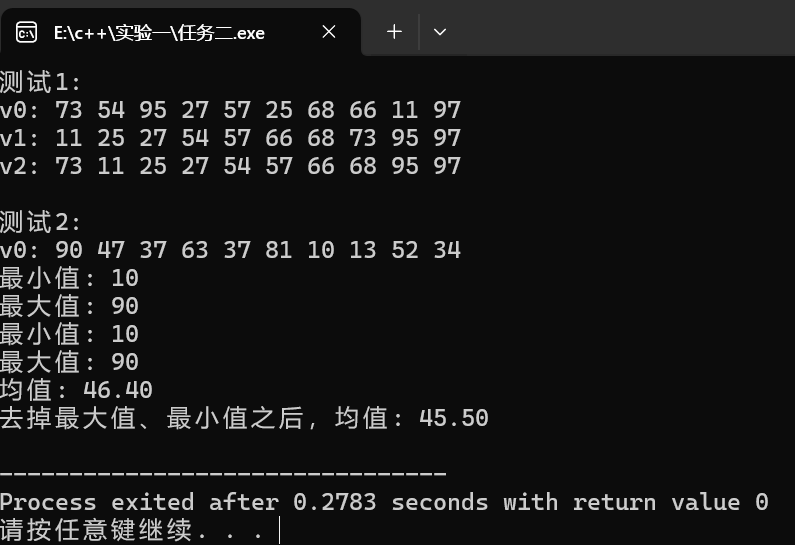
问题一:generate算法用于对给定范围内的每个元素执行指定的函数或操作。
问题二:minmax_element函数可以同时找到序列中的最小值和最大值。相比分别调用min_element和max_element,其可以使代码更简洁,并且只要遍历一次。
问题三:generate的第三个参数用于生成0到100的随机整数。与使用自定义函数相比,lambda表达式的使用场景是其可以定义在有需要的地方,使代码更简洁。
实验任务三
源代码

#include <iostream> #include <string> #include <algorithm> #include <cctype> unsigned char func(unsigned char c); void test1(); void test2(); int main() { std::cout << "测试1: 字符串大小写转换\n"; test1(); std::cout << "\n测试2: 字符变换\n"; test2(); } unsigned char func(unsigned char c) { if(c == 'z') return 'a'; if(c == 'Z') return 'A'; if(std::isalpha(c)) return static_cast<unsigned char>(c+1); return c; } void test1() { std::string s1{"Hello World 2049!"}; std::cout << "s1 = " << s1 << '\n'; std::string s2; for(auto c: s1) s2 += std::tolower(c); std::cout << "s2 = " << s2 << '\n'; std::string s3; for(auto c: s1) s3 += std::toupper(c); std::cout << "s3 = " << s3 << '\n'; } void test2() { std::string s1{"I love cosmos!"}; std::cout << "s1 = " << s1 << '\n'; std::string s2(s1.size(), ' '); std::transform(s1.begin(), s1.end(), s2.begin(), func); std::cout << "s2 = " << s2 << '\n'; }
运行结果
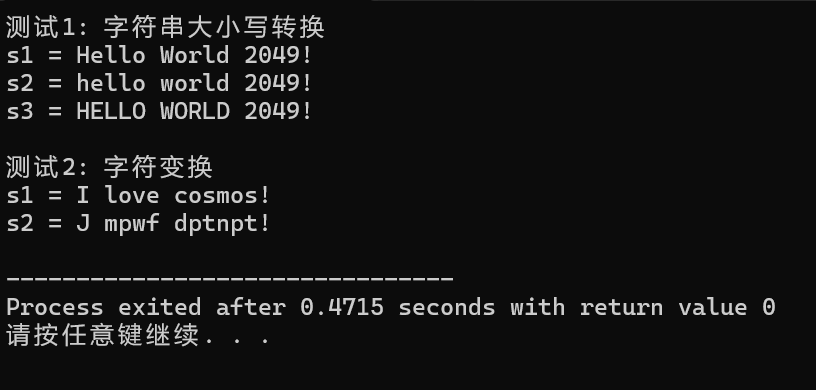
问题一:func函数的功能取决于其具体定义,这道题中是接受一个unsigned char类型的参数c,并根据参数的值返回不同的结果,具体来看是进行字符的转换。
问题二:tolower函数将一个字符转换为对应的小写字母,如果字符已经是小写或者不是字母,则返回原字符。toupper函数将一个字符转化为对应的大写字母。如果字符已经是大写或不是字母,则返回原字符。
问题三:第一个参数是输入范围的起始位置,第二个参数是输入范围的结束位置,第三个参数是输出范围的起始位置,第四个参数是输出范围的结束位置。
实验任务四
源代码

#include <iostream> #include <string> #include <algorithm> bool is_palindrome(const std::string &s); bool is_palindrome_ignore_case(const std::string &s); int main() { using namespace std; string s; // 多组输入,直到按下Ctrl+Z结束测试 while(cin >> s) { cout << boolalpha << "区分大小写: " << is_palindrome(s) << "\n" << "不区分大小写: " << is_palindrome_ignore_case(s) << "\n\n"; } } bool is_palindrome(const std::string &s){ int start=0; int end=s.length()-1; while(start<end){ if(s[start]!=s[end]){ return false; } start++; end--; } return true; } bool is_palindrome_ignore_case(const std::string& s){ std::string s1; for (auto i : s) { s1 += tolower(i); } return is_palindrome(s1); }
运行结果
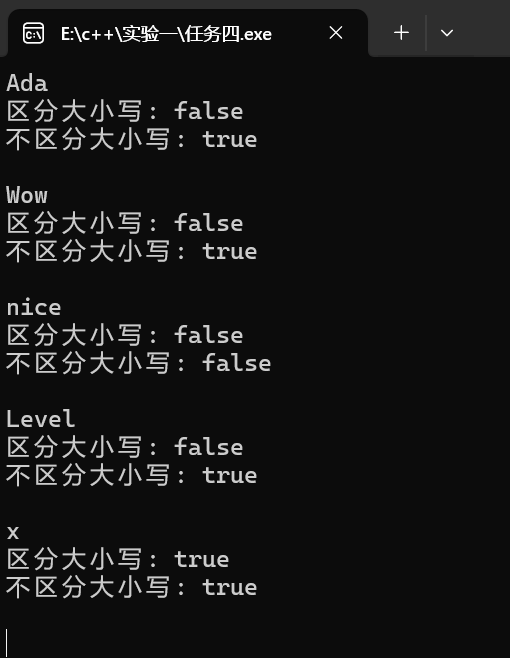
问题一:使用getline(cin,s)来读取包含空格的整行输入。
实验任务五
源代码

#include <iostream> #include <string> #include <algorithm> std::string dec2n(int x, int n = 2); int main() { int x; while(std::cin >> x) { std::cout << "十进制: " << x << '\n' << "二进制: " << dec2n(x) << '\n' << "八进制: " << dec2n(x, 8) << '\n' << "十二进制: " << dec2n(x, 12) << '\n' << "十六进制: " << dec2n(x, 16) << '\n' << "三十二进制: " << dec2n(x, 32) << "\n\n"; } } std::string dec2n(int x,int n){ std::string m; if(!x) return "0"; while(x>0){ int t=x%n; x/=n; if(t<10){ m.insert(0,1,t+'0'); }else{ m.insert(0,1,(t-10)+'A'); } } return m; }
运行结果

实验任务六
源代码

#include <iostream> #include <string> #include <algorithm> #include <iomanip> int main() { std::string start; for (int i = 0; i < 26; i++) { start += static_cast<char>(97 + i); } std::cout << " "; for (int i = 0; i < 26; i++) { std::cout << start[i] << " "; } std::cout << std::endl; for (int i = 1; i <= 26; i++) { std::cout << std::setw(2) << i << " "; std::rotate(start.begin(), start.begin() + 1, start.end()); for (int j = 0; j < 26; j++) { std::cout << static_cast<char>(toupper(start[j])) << " "; } std::cout << std::endl; } }
运行结果
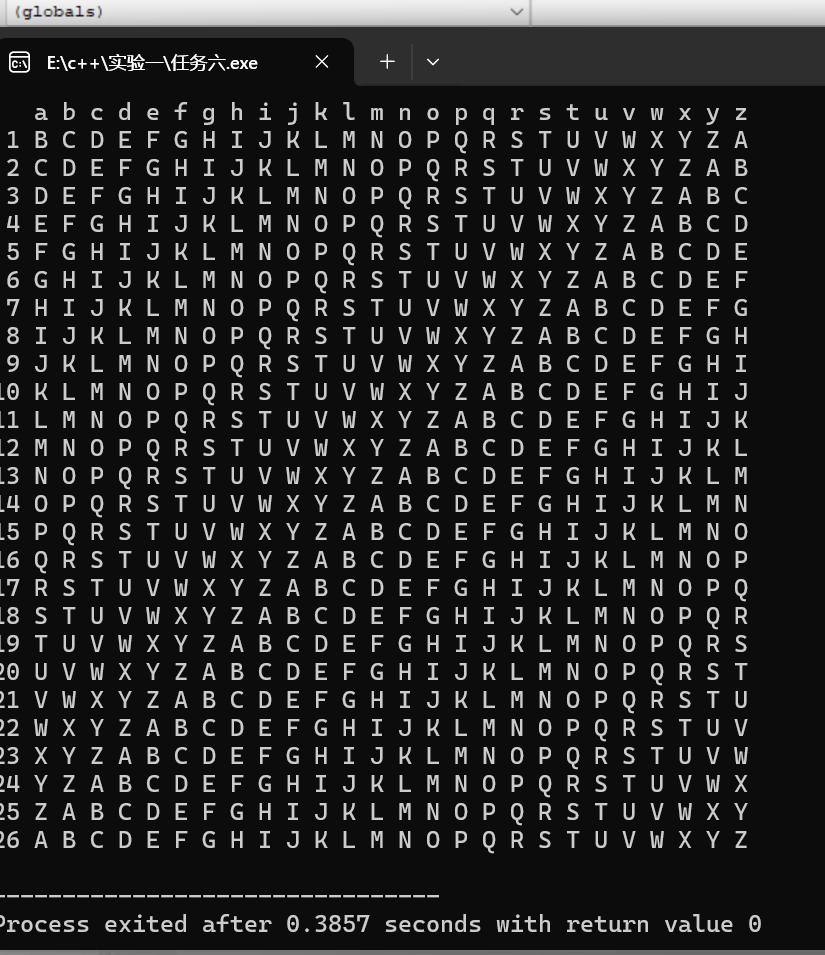
实验任务七
源代码

#include <iostream> #include <string> #include <algorithm> #include <ctime> bool generate(){ int z; char s[4]={'*','/','-','+'}; char c=s[std::rand()%4]; if(c=='-'){ int x=std::rand()%11, y=std::rand() % (x + 1); std::cout << x << " - " << y << " = "; z= x-y; } else if(c=='+'){ int x=std::rand()%11,y=std::rand()%11; std::cout<<x<<"+"<<y<<"="; z= x+y; } else if(c=='*'){ int x=std::rand() % 11, y=std::rand()%11; std::cout<<x<<"*"<<y<<"="; z= x*y; } else if(c=='/'){ int y=std::rand()%11, x=y*(std::rand()%(10/y+1)); std::cout<<x<<" / "<<y<<"="; z=x/y; } int n; std::cin >>n; std::cout<<std::endl; if (n==z) return true; return false; } int main(){ std::srand(time(nullptr)); int m=0; for (int i=0; i<10;i++){ if (generate()) m++; } std::cout<<"正确率:"<<10.0 *m<<"%"<<std::endl; return 0; }
运行结果
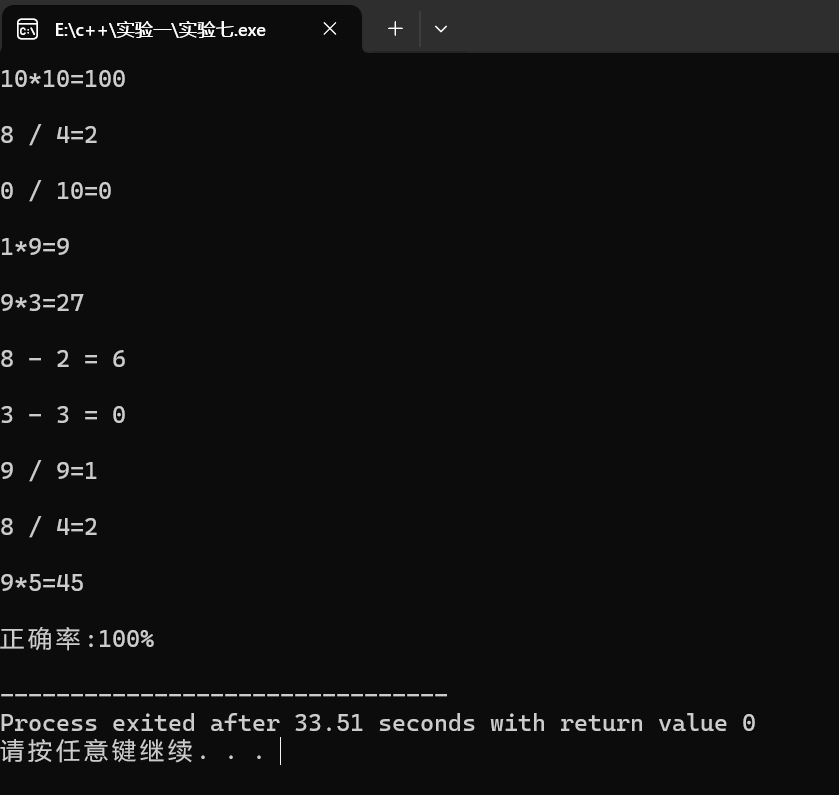





 浙公网安备 33010602011771号
浙公网安备 33010602011771号